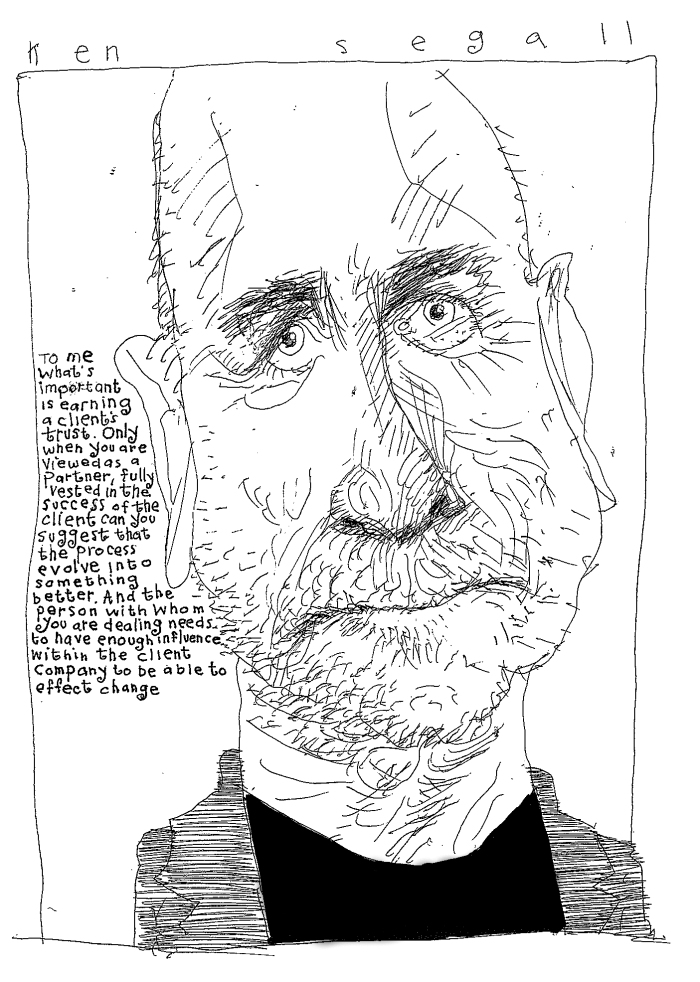There is a peculiar form of Stockholm Syndrome that is unique to advertising, where agencies not only become inured to the nasty, brutish and short outbursts of their clients, but they actually develop an elaborate exegesis about them that would impress legal scholars and fantasy football experts alike.
This is not necessarily a bad thing. The better you understand your client, the better off you are. The better you understand their business, industry, competitors and consumers, the better partner you can be and the better solutions you can provide.
But it is true also of their culture and even of themselves. The better you understand what they mean when they say “this is terrible!” or “this is great” or even “the quick brown fox jumped over the lazy dog!” the better you’ll be able to discuss what’s ailing them, provide them with what they want, or tell them to go to hell.
This is, intended or not, perhaps the most important lesson of Ken Segall’s Insanely Simple, a book that, on the face of it, is about how to apply what has made Apple great to your business. Segall was a CD at TBWA/Chiat/Day on the Apple business through the return of Steve Jobs and the introduction of the iMac, the iPod, the iPhone and, perhaps most importantly, the “The Crazy Ones/Think Different” campaign, and this long connection with Apple gave him insight – on a daily, nightly and even hourly basis – into what made Apple work.
The answer is “simplicity”, which Mr. Segall discusses in great depth and in a variety of ways. For example, “simplicity”, he writes, is not a goal, it is a skill. And second, it’s not all-powerful:
Quality counts. If you start with something truly fresh and compelling, then applying the principles of simplicity can take you to fantastic heights. However a bad idea remains a bad idea no matter how you try to simplify it.
And third, it relies heavily on commitment:
Remember, simplicity is an all-or-none proposition. No picking and choosing allowed. If you can only muster up the energy to buy into part of it, you’re just going to hurt yourself trying.
And while we do not dispute that simplicity is extremely valuable – to Apple and anyone – we also believe it was not the only – and perhaps not even the most important – thing that made Apple successful.
Jobs and Apple showed a fanatical dedication to looking at technology – and therefore, their products – from the consumer’s point-of-view. Indeed, from the point of view of consumers who were nowhere near as interested in technology as they were.
It was this approach – which often looks like simplicity in retrospect – that not only made Apple successful but distinguishes it from companies like Dell and Intel (which Mr. Segall has also worked on and who come in for some pretty damning criticism throughout the book). It is this ability which Apple can trace back to its very beginnings that has consistently been the key to Apple’s success. They are adept at not simply fishing where the fish are, but at fishing the way fish want to be caught.
This, of course, is not simple to do, and as Mr. Segall chronicles, it wasn’t simple at Apple either. Insanely Simple is full of the kinds of behind-the-scenes stories that have made Steve Jobs – and his outbursts, rants and brutality – as legendary as the products he helped produce.
Which means one can come away from the book thinking “Wow – I sure am glad I didn’t have to work with an asshole like that”. But that would miss the point. Not the point of the value of simplicity, nor about thinking like your customers. But the point about understanding how to communicate with your client. Again and again Segall demonstrates how he and his team altered their operating procedure, their expectations, their process in order to work more smoothly and efficiently with Jobs and Apple.
To be clear, we’re not talking about the kind of order-taking and rolling-over that has always been endemic at the worst agencies (and exists even at the best agencies when they are at their lowest ebbs). Indeed, “Insanely Simple” is full of examples when Segall and his team disagreed with Jobs and when (gasp!) Jobs was ultimately wrong and they were right.
Instead, this is about communication. Advertising is a business of human beings talking to other human beings. Understanding who you’re talking to, how they hear what you say, and what they mean when they talk is vitally important.
Wherever it occurs.
Insanely Simple: The Obsession That Drives Apple’s Success by Ken Segall was published by Portfolio/Penguin on 06/26/12 – order it from Amazon here or from Barnes & Noble here – or pick it up at your local bookseller (find one here).
Please be advised that The Agency Review is an Amazon Associate and as such earns a commission from qualifying purchases
You May Also Want to Read:

author of Insanely Simple


“Advertising is a business of human beings talking to other human beings.” Quite often, it’s a business of corporations mumbling incoherently to themselves. But yes, ideally, under the right conditions, what you describe does indeed happen 🙂
Very valid point – consumers are not necessarily interested in all of the technical specs and know-how that happens from the other side of the curtain. They want things to be as easy as possible, after all, who wants to make things harder for themselves?! Such a simple concept, and yet so effective 🙂